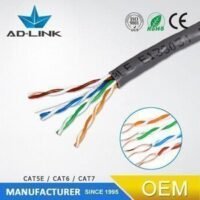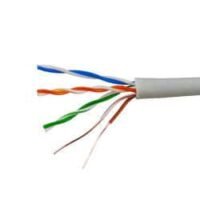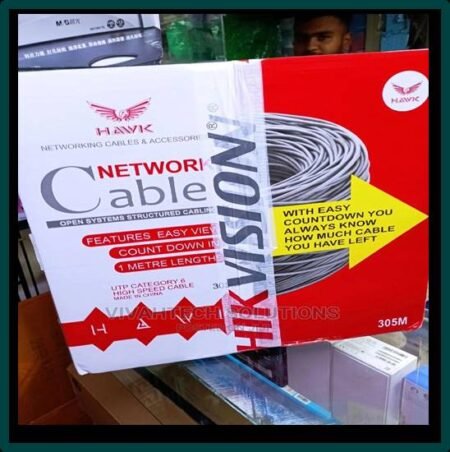Ethernet Cables for Structured Cabling and Local Area Network (LAN ) Infrastructure
Create reliable Local Area Network (LAN) Cabling Infrastructure with quality Ethernet cables from TDK Solutions; Leaders in quality and Price for Ethernet Cables in Kenya.
We stock Network Cables from all major brands. top structured cabling manufacturers’ brands preferred by technicians in Kenya such as;
Solid Ethernet Cables; Siemon Cat 6 /7 Cables, Giganet Cat 6 Cables, Arnet, Dahua Network Cables, D-Link, Hikvison, APS, Ubiquiti Tough Cable,
We Also stock popular Stranded AN Network Cable brands such as HST, EaseNet, ACP, A-Dlink, Aico, Office Point, and FastNet.
LAN Ethernet Cables
LAN Ethernet Cables
LAN Ethernet Cables
Cat 6 Outdoor Cable UV Shielded & Weatherproof ACC- Aluminium ClaD Copper
LAN Ethernet Cables
LAN Ethernet Cables
LAN Ethernet Cables
LAN Ethernet Cables
LAN Ethernet Cables
LAN Ethernet Cables
LAN Ethernet Cables
LAN Ethernet Cables
LAN Ethernet Cables
LAN Ethernet Cables
LAN Ethernet Cables
LAN Ethernet Cables
LAN Ethernet Cables
LAN Ethernet Cables
LAN Ethernet Cables
LAN Ethernet Cables
LAN Ethernet Cables
LAN Ethernet Cables
LAN Ethernet Cables
LAN Ethernet Cables
LAN Ethernet Cables
LAN Ethernet Cables
LAN Ethernet Cables
LAN Ethernet Cables
LAN Ethernet Cables
LAN Ethernet Cables
LAN Ethernet Cables
LAN Ethernet Cables
LAN Ethernet Cables
LAN Ethernet Cables
LAN Ethernet Cables
LAN Ethernet Cables
Types of Ethernet Cables and There applications
Ethernet Cables, or as they are commonly referred to LAN – Network cables provide a means of connecting devices to a network, they all perform a basic function, Connecting devices to the Ethernet Network. The main difference in types of Ethernet Cable is based on performance and speed,
The most common Ethernet cables that support industry networking standards are Category 5e (Cat5e), Cat a Cat 6e and Cat 7
Cat,” in this case, stands for “Category.” When buying Ethernet cables, The minimum you should go is cat5E Lower standard cables aren’t actually Ethernet cables, offer very low speeds, and are typically used for telephone applications.
Here’s the difference between the main types of cables you’ll be buying:
Cat-5 cables offer speeds up to 100 Megabits per second and operate at 100 MHz
Cat-5e cables offer speeds of up to 1 Gigabit per second and operate at 100 MHz
Cat-6 cables offer speeds of up to 10 Gigabits per second, though using this full capacity shortens the maximum length of the cable down to 55 meters as opposed to the 100 meters normally offered by Cat cables. These cables also run at 250 MHz
Cat-6e cables offer speeds of up to 10 Gigabits per second, with no such length restriction as their predecessor. These cables run at 500 MHz
You may be wondering what type of cable is best for you. To test it most simply, run a speed test to gauge your connection speed or ask your ISP
Network Ethernet cables are manufactured in two main forms
Solid Pure Copper (80-95) % Copper Ethernet and Bare copper Cables with a copper percentage ranging from 50- 80 %
Solid Ethernet cables offer slightly better performance and improved protection against electrical interference. They’re also commonly used in setting up enterprise network Infrastructure: Cabling inside office walls,
Stranded / Bare Ethernet cables are less prone to physical cracks and breaks, making them more suitable for travelers or in-home network setups.
Crossover Ethernet Cables can connect two computers
Limitations of Ethernet Cables when creating Networks
Signal Loss (Attenuation) with increased distance because the electrical resistance of a long cable affects performance. Ethernet cables have a maximum distance capacity usually 80-100m before there is a signal loss.
For best performance from the Ethernet Cables, The Data Cable should be short ends of the cable should be close enough to each other to receive signals quickly, and far enough away from outside electrical interference to avoid interruptions.
Designing a network with Cat 5e Ethernet Cables
The maximum length of a solid Ethernet CAT5 cable, before attenuation occurs, is 324 feet. CAT6 can go up to 700 feet.
Ethernet cables can be longer but may suffer from signal loss, especially if they pass near large electrical appliances.
Short Network cables likely to suffer from reflection. However, some people have reported no problems with cable lengths as low as 4 inches.
RJ 45 Cables and RJ-45 Ethernet Connectors
There are different types of RJ-45 connectors. Cat 6 and Cat 5 RJ 45. can sometimes be used interchangeably.
Cat 6e and Cat 7 Cables have different designs for use with stranded cables and are incompatible with solid cables.
Ethernet Cabling alternative for small office networks, Small OFFICE Computer Networking, and Networking for Small Homes
Most small business Networking gadgets and Home Based computing and Networking Equipment come equipped with Wireless Networking Adapters such as Wi-Fi and Bluetooth
Most Routers, Computers, Phones, Printers Tablets, don’t have a network port. These wireless technologies provide advantages when cabling could make the office place dis-organized, or when there is no room/ space to run cables
Category 6 Cat6 a and Cat 6e Ethernet Cables
Cat 6 cables come in solid or stranded models, the solid models offer slightly better performance than the Stranded models, and Cat6 Network Cables outstrip the performance of its cat5 LAN Ethernet RJ 45 predecessors.
10G- gigabit Ethernet cables * Cat 6e Up to 55M standards, 1G –gigabit LAN Cables Cat 5e up to 100m
Pure copper Cables such as Giganet Cat6 Cables, Siemon Cat 6 Cables, and Dahua LAN Cables offer the best solid LAN Cables
When measured in 100m lengths Cat6 Network Cable can easily provide the 1Gbps transfers offered by cat5e but have the added benefit of pushing itself to 10Gbps when measured under 55 meters.
Category 6 Networking Cables operate on a higher frequency than cat 5 cables (250 MHz to be exact), which goes a long way towards eliminating and limiting interference from electronic devices.
Cat6 Cables can have no advantage over cat5e Ethernet Cables if the network speeds provided by your devices are lower. CAT 6 Cables tend to cost quite a bit more than the cat 5 cables. Always Ensure that b your network can match the speeds that they offer so that you can fully utilize the cables. If not, you are only going to better the transfer speeds associated with your local network.
Choosing CAT 6 over Cat 5e Ethernet Cables
All Cat6 cables are designed to be backward compatible, these make them versatile in networking applications. This means you can use them even on older routers and switches. Cat 6 cables will boost transfer speeds between devices in the Local Area Network and Eliminate Interference
Cat6 LAN Cables can provide a staggering 10 times the transfer rates of cat5e cables, making them perfect for homes or businesses with high bandwidth needs.
The Cat6 Cables use of higher frequencies thus eliminating interference from other LAN cables
Cat6 cables will only provide you with speeds that your router and internet service provider can give, so don’t expect it to boost performance on older devices. You may not need it if your ISP has a slower speed.
Remember that if any of your network components are not gigabit-rated, your network can only operate as quickly as its slowest device.
Category 6a Ethernet Cables. Fast Speeds. Low Interference
Category 6a Ethernet cables will have much higher speeds and reliability than any of the abovementioned ones, and they are as good as using fiber optics Cables.
Applications of Cat 6a Ethernet Cables
The most common application of these cat 6a cables is in industrial and enterprise-level networks. These cables are also more suited in complex office networks or in complex Residential setups
CAT 6a Cables can deliver 10G speeds up to 100M, Are a bit bigger than normal hence not easy to work with
When measured by 100 meters, Cat6a cables can provide you with connection speeds of up to 10Gbps (as opposed to cat6 cables which can only do that with 55 meters of cabling).
The major feature of cat6a cables is that they operate on 500 MHz, which practically eliminates all local interference which could hurt the quality of your network connections.
The cat 6a LAN Cables are ideal for large setups such as media houses where the transfer of data across the local network is as crucial a good example is a Media house that would need to transfer incredibly large files on the daily. Then designing the network with CAT 6a Cables makes sense since it enables the network and has the infrastructure capacity to take full advantage of CAT6E cables,
Top Reasons for choosing Cat6a Networking Cables for your office structured Cabling projects
Cat6a cables provide much higher speeds 10Gigabit Speeds up to 100M these make it ideal for extremely high bandwidth tasks whether over the net or the local network.
The cables have high Reliability have interference on a 500 MHz frequency and are also more robustly wound to further eliminate electronic interference.
The Best Ethernet Cable for Setting up One Office Network, Cyber, Home and Non-Commercial Network
| Cat 5e | Unshielded | 1,000 Mbps / 1 Gbps | 100 MHz |
| Cat 6 | Shielded or Unshielded | 1,000 Mbps / 1 Gbps 10G Speeds up 55M | 250 MHz |
The Best Ethernet Cable for setting up a serious Structured cabling Enterprise Level LAN Network
| Cat 6 | Shielded or Unshielded | 1,000 Mbps / 1 Gbps 10 Gbps up to 55M | 250 MHz |
| Cat 6a | Shielded | 10,000 Mbps / 10 Gbps up to 100m | 500 MHz |
| Cat 7 | Shielded | 10,000 Mbps / 10 Gbps | 600 MHz |
| Cat 7a | Shielded | 10,000 Mbps/10 Gbps | 1,000Mhz |
Definitions List of Ethernet Network Cables
Cat 5e Ethernet Cables.
The “e” in Cat 5e stands for “enhanced.” Category 5e LAN Cables is built under more stringent testing standards to eliminate crosstalk — i.e., the unwanted transfer of signals between communication channels. Cat 5e is currently the most common type of Ethernet cable, mainly due to its low production cost and ability to support faster speeds than the original Cat 5 cables.
Cat 6e Networking Cables
Cat 6 cables, the most common cables in Small Business and Non-Commercial Ethernet Applications. The RJ 45 Cable can support much higher bandwidths than Cat 5 and Cat 5e cables. Solid Cat6e cables are outfitted with foil or braided shielding.
This shielding acts as a protection for the twisted pairs of wires inside the Ethernet cable, Shielding cables help in elimination of crosstalk and noise interference.
Cat 6 cables can technically support speeds up to 10 Gbps, but can only do so for up to 55 meters. And their best performance is as good as the slowest gadget in your Network Infrastructure
Cat 6a LAN Cables
The “a” in Cat 6a stands for “augmented.” Unlike the regular Cat 6 cables, Category 6a Lan Cables support twice the maximum bandwidth and are capable of maintaining higher transmission speeds over longer cable lengths.
All Cat 6a Network cables have a foiled shielding and a sheathing ( These make it much thicker ) The double shielding is thick enough to eliminate crosstalk, The downside is the cable. Is stiff, making it harder to run cabling in pipes, Terminate or Bend
Cat 7
Cat 7 cables utilize the newest widely available Ethernet technology and support higher bandwidths and significantly faster transmission speeds than Cat 6 cables.
They’re proportionally more expensive than other Ethernet cables, though their performance reflects their premium price tag. Cat 7 cables are capable of reaching up to 100 Gbps at a range of 15 meters, making them an excellent choice for connecting modems or routers directly to your devices. Cat 7 cables are always shielded and use a modified GigaGate45 connector, which is backward compatible with regular Ethernet ports.
Cat 7a
Although not widely available and with few supporting networking hardware options, Cat 7a currently offers the highest-specification Ethernet cables you can buy.
Although the transmission speed is no different than that of Cat 7, Cat 7a cables offer a more than 50 percent improvement in overall bandwidth, which in certain settings may be useful. They are far more expensive than any other options though, and so they should only really be considered in very niche cases.
Ethernet Cabling Terms Definition
When working with Ethernet cables, the differences between the cables is simple and the choice depends on either speed.
Cat: Industry-standard code name for “category.”
TP: Twisted Pairs. This refers to the way that the wires inside the cable are twisted together. Twisted Pairs have been an IEE Ethernet Cabling standard. Twisted pairs are inferior to fiber-optic cabling in terms of maximum length and speed drop-off.
UTP: Unshielded Twisted Pairs. Cables designated as UTP don’t have any foils or shielding. This makes the cable extremely flexible to work with. The cable is suitable for isolated areas that do not have much electronic interference. UTP greatly sacrifices signal quality and increases vulnerability for crosstalk.
STP: Shielded Twisted Pairs. Cables with STP are protected with braided shielding, which is usually made of copper or another conductive polymer. CAT 6 and CAT 7 Shielding reduces noise and improves connection quality.
FTP: Foiled Twisted Pairs. Cables with FTP or SFTP designations are protected with foil shielding, which helps reduce noise and improves connection quality









































